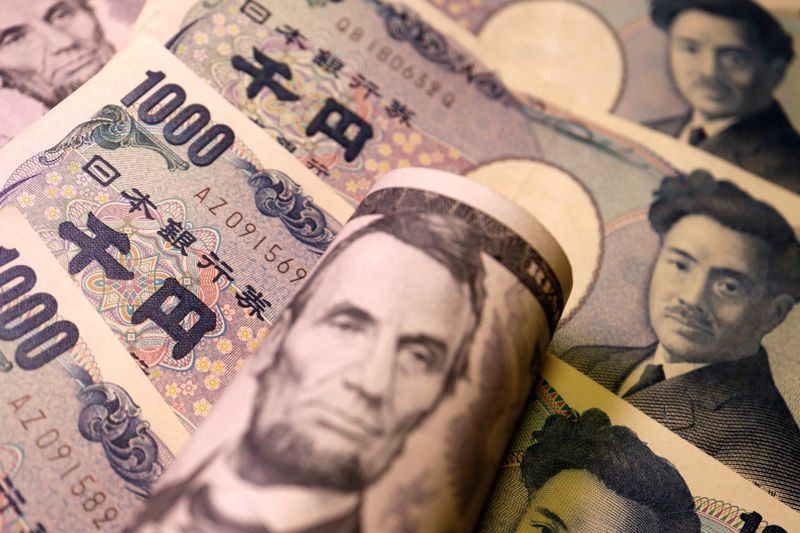Forex
Dollar hits 7-month high vs yen on policy split; Sweden’s crown touches record low


© Reuters. Japanese yen and U.S. dollar banknotes are seen in this illustration picture taken June 15, 2022. REUTERS/Florence Lo/Illustration
By Samuel Indyk and Kevin Buckland
LONDON (Reuters) – The U.S. dollar touched a more than seven-month high against the yen on Thursday after the heads of the respective central banks reaffirmed the divergence in policy, while Sweden’s crown hit a record low after the Riksbank modestly raised its policy rate.
Federal Reserve Chair Jerome Powell – speaking on a panel with European Central Bank President Christine Lagarde, Bank of Japan Governor Kazuo Ueda and Bank of England Governor Andrew Bailey – noted that two rate rises were likely this year, and did not rule out the possibility of a hike in July.
By contrast, Ueda reiterated that “there’s still some distance to go” in sustainably achieving 2% inflation accompanied by sufficient wage growth, the conditions the BOJ has set for considering an exit from ultra-easy stimulus.
The dollar’s surge of as much as 11.6% since late March to reach 144.71 yen for the first time since Nov. 10 has prompted increased verbal warnings from Japanese government officials this week that the move may have been too rapid.
The ministry of finance and BOJ intervened in the currency market last autumn when the dollar strengthened beyond 145 yen.
The dollar was last down 0.1% at 144.24.
“The playbook of verbal intervention is consistent with intervention happening soon and if it gets above 145 we could quite easily get to see them intervene again,” said ING global head of markets Chris Turner.
“Last year they were bailed out by U.S. rates, inflation and the dollar all turning lower but this time around there’s a risk they might get sucked into a longer campaign if inflation proves sticky.”
The – which measures the currency against six major peers, including the yen, euro and sterling – was flat at 102.94.
Sweden’s crown briefly hit a record low of 11.829 per euro after Sweden’s Riksbank raised its key interest rate and increased its pace of bond sales, or quantitative tightening (QT). The crown was last little changed at 11.77 per euro.
“They’re expressing confidence that a faster rate of QT is going to deliver a stronger crown and I think that’s a bit unproven,” ING’s Turner said.
“One of the arguments of providing government bonds back to the open market is that they can improve liquidity and deliver higher bond yields but the crown hasn’t really bought into that just yet.”
The euro was little changed at $1.0908, after mixed inflation data from German states and Spain ahead of tomorrow’s euro area wide figure.
Consumer prices in North Rhine Westphalia, Germany’s most populous state, rose 6.2% on an annual basis in June, up from 5.7% in May.
Meanwhile, Spain’s 12-month inflation fell to 1.9%, the lowest since March 2021 but above the 1.7% expected by economists polled by Reuters.
The weakened toward a seven-month trough despite the People’s Bank of China (PBOC) setting a much stronger than expected official rate, in the latest signal of its discomfort at the pace of recent declines.
The dollar added 0.1% to 7.2479 yuan in the offshore market, taking it close to the previous day’s 7-1/2-month low of 7.2694.
The PBOC set the midpoint rate at 7.2208, in what analysts at Citi called “the most forceful sign yet of official discomfort at the pace of yuan depreciation,” although adding they are “doubtful this will prevent more upside, as it has proven ineffective over time in the past.”
Elsewhere, the Australian dollar rose 0.4% to $0.6625 after stronger than expected retail sales data, regaining some composure following Wednesday’s 1.27% tumble.

 Forex3 years ago
Forex3 years agoForex Today: the dollar is gaining strength amid gloomy sentiment at the start of the Fed’s week

 Forex3 years ago
Forex3 years agoUnbiased review of Pocket Option broker

 Forex3 years ago
Forex3 years agoDollar to pound sterling exchange rate today: Pound plummeted to its lowest since 1985

 Forex3 years ago
Forex3 years agoHow is the Australian dollar doing today?

 Cryptocurrency3 years ago
Cryptocurrency3 years agoWhat happened in the crypto market – current events today

 World3 years ago
World3 years agoWhy are modern video games an art form?

 Commodities3 years ago
Commodities3 years agoCopper continues to fall in price on expectations of lower demand in China

 Economy3 years ago
Economy3 years agoCrude oil tankers double in price due to EU anti-Russian sanctions























